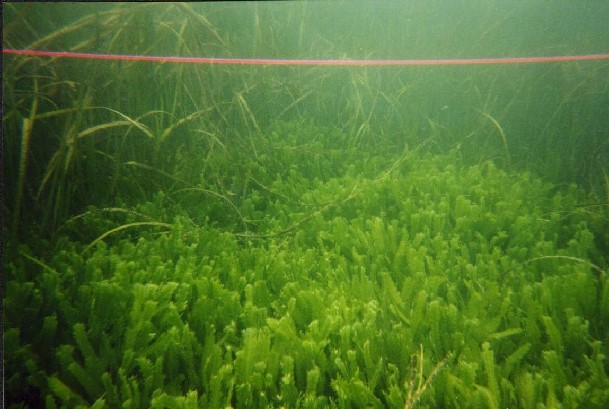

Caulerpa taxifolia: The "killer algae" is in Southern California!
A non-native and highly invasive marine seaweed, Caulerpa taxifolia (hereafter Caulerpa), nicknamed the "killer algae," was discovered in two Southern California locations in summer 2000. Although Caulerpa poses no threat to human health, it may have devastating economic and environmental consequences for California if it becomes permanently established. Caulerpa is a great example of what can happen when non-native or nonindigenous invasive species (NIS), which includes plants, animals, and diseases they carry, are introduced to areas beyond their natural range. Non-native aquatic organisms can be found in coastal and inland waters worldwide. Though some non-native species introductions may have minimal effects on their new habitat, many invasive species can have enormous negative impacts on our economy and environment.
Why the concern?
This non-native seaweed threatens California's coastal marine
life, including kelp forests, fish, eelgrass beds, marine mammals,
and sea birds. When introduced to a non-native area, it can displace
native algae and negatively impacts the coastal ecosystem. Fish,
invertebrates, marine mammals, and sea birds are adversely affected.
Caulerpa can form a dense, smothering blanket on any surface
including rock, sand, or mud, and can grow in shallow or deeper
ocean waters. It is capable of growing up to one inch per day,
and can survive up to ten days out of water. Any small fragment
of this seaweed has the potential to start a new colony.
What does it look
like?
Caulerpa is bright green with leafy (fern-like)
fronds that extend upward from each main stem. Each stem can grow
up to nine feet in length. This alga can be found as individual
plants or in dense blankets that may cover acres of ocean bottom.
Imagine "laying "astro-turf on the ocean floor"
- that is the potential of a Caulerpa infestation.
 |
|
 |
|
| Photos courtesy of Rachel Woodfield and the San Diego Regional Water Quality Control Board | |
Where did it come from?
Caulerpa is most commonly used in home aquariums.
Caulerpa taxifolia is a saltwater plant native to tropical
waters, but a released or escaped aquarium-bred hybrid of it invaded
the Mediterranean Sea in 1984. The Caulerpa found in California
is actually a clone of the Mediterranean plant. This Mediterranean
strain, which is not native to the Mediterranean Sea, is an extremely
rapidly growing and invasive alga that has spread across thousands
of acres and has decreased the biodiversity and abundance of native
plant and animal species throughout the Mediterranean Sea. The
Caulerpa invasion of the Mediterranean has also resulted
in substantial losses to local fishing communities due to fouling
of fishing nets and related gear. Given the habitat requirements
of this alga, it has the potential to invade large areas of Southern
California as well as areas in the San Francisco Bay-Delta, with
potentially similar catastrophic ecological and commercial impacts
as those experienced in the Mediterranean.
In the Mediterranean, the spread of Caulerpa has harmed
tourism, boating, diving, and commercial fishing - both by altering
the distribution of fish as well as fouling fishing gear. The
plant contains a toxin that is not harmful to humans but most
fish and invertebrates avoid it and it may be lethal to many species.
Fish, invertebrates, marine mammals, and sea birds that are dependent
on native marine vegetation are displaced or die-off from areas
where they once thrived.
This alga poses a substantial threat to California marine ecosystems,
particularly to eelgrass beds, that make our waters such a rich
and productive environment for fish and birds. Coastal resources
that may be directly impacted by an invasion of Caulerpa
are part of a food web that is critical to the survival of numerous
native marine species including the commercially and recreationally
important spiny lobster, California halibut, and sand basses.
How was it introduced
and how does it spread?
Release from a home aquarium is the most likely source of the
Caulerpa found in Southern California due to the popularity
of this fast-growing, hardy species. Although importation into
the United States and interstate transport or sale has been banned
since 1999, Caulerpa taxifolia continues to be part of
the aquarium trade. The infestation in Southern California is
currently undergoing eradication efforts under the guidance of
the Southern California Caulerpa Action Team (SCCAT), with an
expected price tag of $5 million. One torn leaf can produce a
new plant so eradication is difficult. Dispersal of Caulerpa
taxifolia throughout the Mediterranean is believed to be primarily
attributable to fishing gear, boat anchors and anchor lines.
The Mediterranean strain of Caulerpa was prohibited under
the U.S. Federal Noxious Weed Act in 1999. Since then, importation
into the United States, as well as interstate transport and sale,
including via the Internet, has been a federal offense. In 2001, the
California legislature banned the possession, sale, importation, transportation
and release of C. taxifolia and eight similar-looking Caluerpa species
in California. The city of San Diego recently banned
the possession and sale of the entire Caulerpa genus.
Your help is needed!
What YOU can do to prevent future introductions or detect new
patches of growth:
Your help is critical
to the success of California's effort to eradicate and prevent
further infestation by this destructive marine seaweed. Boats,
anchors, fishing gear and other aquatic activities can break off
small fragments which can grow into a new plant.
*DO NOT use this seaweed in your aquarium - there are many
alternatives!
*No Dumping! Do not release any water, plants or animals
from an aquarium into a street, storm drains, streams, bay, lagoon,
or the ocean. Only dump aquarium water into a sink or toilet.
If you have large plant fragments, dry them out or freeze them
for 24 hours, and then bag them for trash removal. Caulerpa
can be removed from tanks, with all material it's attached to
(rocks, gravel, etc.), placed in a freezer for 24 hours, and then
placed in the trash for disposal in a landfill.
*Dispose of unused bait, seaweed, or other packing materials
in a lined garbage can, not into storm drains, streams, lakes
or other bodies of water.
*Inspect your boat, trailers, rudders, anchors, marine
sports equipment, and fishing gear for attached plants and animals
and remove them so you do not carry them to a new location. Place
all organisms in a trash bin, not back into the water.
Even small fragments can start new invasions!
*If you find Caulerpa in the water, along the shoreline,
or on your watercraft or fishing gear, carefully remove a small
piece of it, bag and freeze it, and report it
to Bill Paznokas with the California Department of
Fish and Game at wpaznokas@dfg.ca.gov or (858) 467-4218
with the following information:
1. Where you found it (including significant landmarks and water
depth if possible)
2. Your name, telephone number, and address
Thank you for
your assistance!
Additional information
on Caulerpa taxifolia is available at:
San
Diego Regional Water Quality Control Board: http://www.swrcb.ca.gov/resdec/resltn/2000/rs2000-084.doc
Noxious
Seaweed Found in Southern California Coastal Waters: http://swr.nmfs.noaa.gov/hcd/caulerpa.htm
Caulerpa
Eradication in Southern California: http://swr.nmfs.noaa.gov/hcd/caulerad.htm
http://www.swrcb.ca.gov/rwqcb9/programs/caulerpa/caulerpa.html
| Caulerpa
taxifolia page September 2003 - September 2005 (RIDNIS Project: Reducing the Introduction and Distribution of Aquatic Non-Native Invasive Species through Outreach & Education) University of California Cooperative Extension, Department of Environmental Science and Policy |
||
| This project is funded by the CBDA California Bay-Delta Authority in cooperation with the University of California Cooperative Extension. | ||
   |